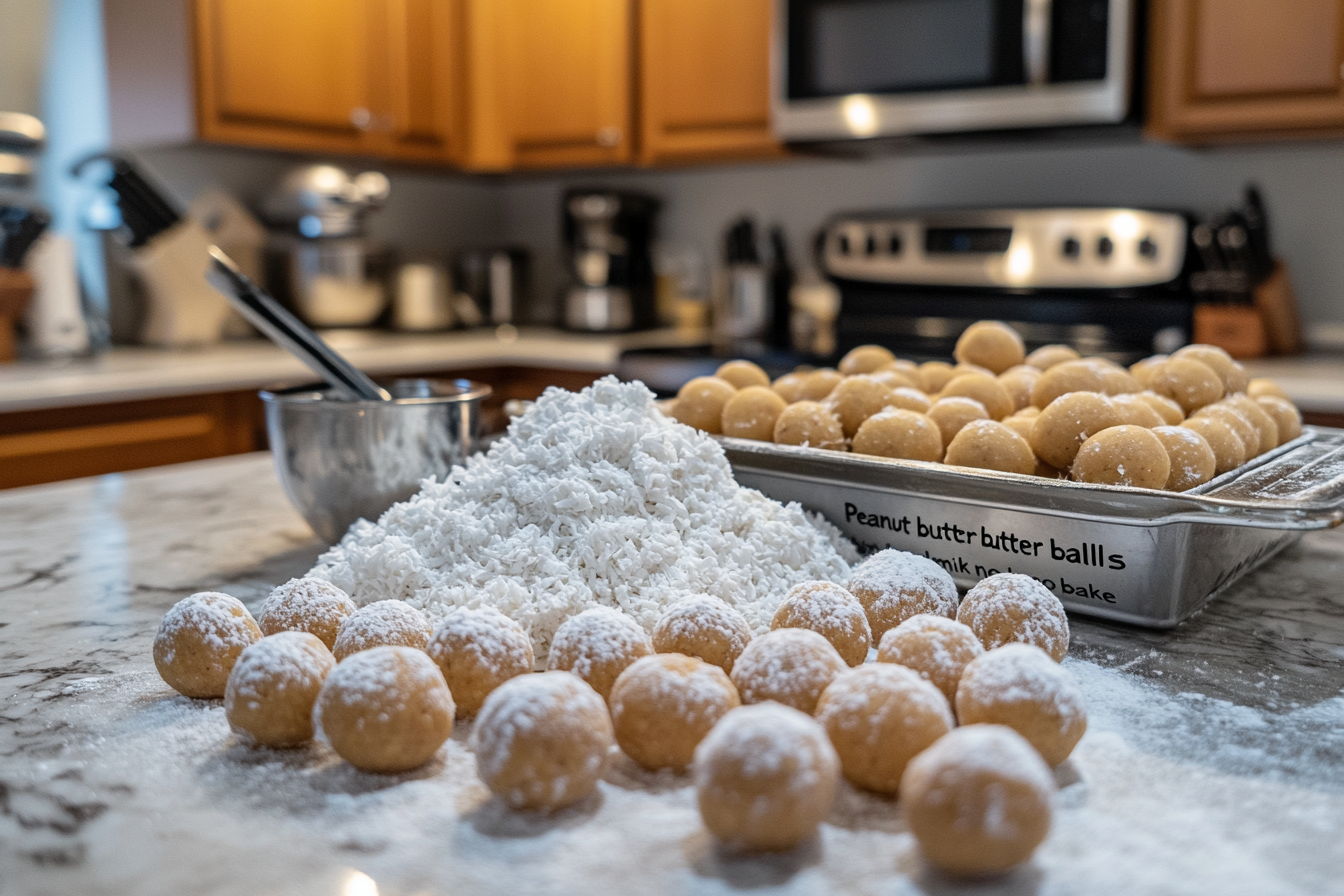No-Bake Peanut Butter Balls with Coconut are a delicious, easy-to-make treat that combines the creamy richness of peanut butter with the tropical sweetness of coconut and the smooth texture of powdered milk. Perfect for busy days, parties, or a quick energy boost, these treats are customizable, healthy, and require no baking!
Introduction to the Recipe
No-bake desserts have become increasingly popular because they are quick, convenient, and don’t require specialized skills or equipment. These peanut butter balls with coconut and powdered milk are a prime example of how simple ingredients can come together to create something delightful.
Why No-Bake Desserts Are a Great Choice
- Time-Saving: Skip the baking and have your dessert ready in minutes.
- Energy-Efficient: No need to heat the oven, making them perfect for warm days.
- Kid-Friendly: A fun recipe for kids to help with, especially shaping and rolling the balls.
Benefits of Peanut Butter, Coconut, and Powdered Milk
Nutritional Advantages of Peanut Butter
- High in protein and healthy fats, making it a great energy booster.
- Contains essential nutrients like vitamin E, magnesium, and niacin.
Health Benefits of Coconut in Desserts
- Shredded coconut adds dietary fiber and a naturally sweet flavor.
- Coconut contains medium-chain triglycerides (MCTs), which can support energy metabolism.
Powdered Milk for Texture and Creaminess
- Creates a smooth, creamy texture without adding liquid.
- Adds a boost of calcium, vitamin D, and protein.
Essential Ingredients for Peanut Butter Balls
Choosing the Right Peanut Butter
- Opt for natural peanut butter with no added sugars or hydrogenated oils for a healthier option.
- Creamy peanut butter is ideal, but crunchy can be used for added texture.
Using Shredded Coconut and Coconut Oil
- Choose unsweetened shredded coconut for better control over sweetness.
- Coconut oil enhances the flavor and helps bind the mixture.
Sweeteners: Honey, Maple Syrup, or Sugar
- Honey or maple syrup provides natural sweetness and helps hold the ingredients together.
- For a low-sugar option, use stevia or a sugar substitute.
Kitchen Tools and Preparation
Mixing Bowls and Measuring Tools
- Use a large mixing bowl for combining ingredients and a smaller bowl for preparing coatings.
- Accurate measuring cups and spoons ensure consistency in the recipe.
Storage Containers for Finished Balls
- Store in airtight containers to maintain freshness and prevent them from drying out.
Step-by-Step Recipe Instructions for No-Bake Peanut Butter Balls with Coconut and Powdered Milk
Creating these no-bake peanut butter balls is a quick and easy process that requires no special equipment. Follow these simple steps for a delightful treat that’s perfect for snacking, desserts, or parties.
Preparing the Ingredients
Measuring Peanut Butter, Powdered Milk, and Sweeteners
- Peanut Butter: Measure 1 cup of creamy peanut butter (natural or regular).
- Powdered Milk: Use 1/2 cup of powdered milk to add creaminess.
- Sweetener: Add 1/4 cup honey or maple syrup, adjusting to taste.
Toasting Coconut for Added Flavor (Optional)
- Heat a dry skillet over medium heat.
- Add 1/2 cup shredded coconut and stir constantly for 2–3 minutes until golden brown.
- Allow to cool before using as a coating or mix-in.
Mixing the Ingredients Together
Achieving the Perfect Dough Consistency
- In a large mixing bowl, combine the peanut butter, powdered milk, and honey.
- Mix thoroughly with a spoon or spatula until the dough forms a thick, cohesive texture.
- If the mixture feels too dry, add a small amount of coconut oil (1 tsp at a time) to moisten. If too sticky, sprinkle in more powdered milk.
Adding Optional Mix-Ins
- Chocolate Chips: Fold in 1/4 cup for a sweet twist.
- Chopped Nuts: Add 1/4 cup for a crunchy texture.
- Raisins or Dried Cranberries: Mix in for a chewy, fruity contrast.
Shaping and Rolling the Peanut Butter Balls
Forming Uniform Balls with Hands or Scoop
- Scoop out approximately 1 tablespoon of the mixture using a spoon or small cookie scoop.
- Roll the mixture between your palms to form smooth, even balls.
Rolling in Coconut Flakes or Cocoa Powder for Coating
- Place shredded coconut, cocoa powder, or both in separate shallow bowls.
- Roll each peanut butter ball in your preferred coating until fully covered.
Chilling and Storing the Peanut Butter Balls
Setting in the Refrigerator or Freezer
- Arrange the balls on a baking sheet lined with parchment paper.
- Chill in the refrigerator for 30 minutes or place in the freezer for 15 minutes to firm up.
Proper Storage for Freshness
- Store the chilled peanut butter balls in an airtight container.
- Keep in the refrigerator for up to 1 week or freeze for up to 3 months.
Variations and Serving Ideas for No-Bake Peanut Butter Balls with Coconut and Powdered Milk
Elevate your no-bake peanut butter balls by exploring creative recipe variations, serving suggestions, and dietary adaptations. These tips ensure the recipe remains versatile and caters to various preferences.
Recipe Variations for Different Flavors
Adding Cocoa Powder for a Chocolate Twist
- Chocolate Peanut Butter Balls: Add 2 tbsp cocoa powder to the base mixture for a rich, chocolatey flavor.
- Roll the balls in a mixture of cocoa powder and powdered sugar for a decadent finish.
Incorporating Protein Powder for a Healthy Snack
- Replace 1/4 cup powdered milk with your favorite protein powder.
- Choose flavors like vanilla, chocolate, or peanut butter to complement the recipe.
- This variation transforms the balls into a post-workout snack packed with protein.
Spiced Peanut Butter Balls
- Add 1/2 tsp cinnamon or a pinch of nutmeg for a warm, spiced flavor.
- Perfect for fall-themed snacks or holiday treats.
Creative Ways to Serve Peanut Butter Balls
As a Snack, Dessert, or Party Treat
- Snacks: Pack in lunchboxes for a quick, healthy energy boost.
- Dessert: Serve on a platter with chocolate-dipped strawberries or mini brownies.
- Party Treats: Arrange on decorative skewers, alternating with fruits like grapes or bananas.
Pairing with Tea, Coffee, or Milk
- Tea: Pair with a spiced chai or green tea for a light, refreshing combination.
- Coffee: Enjoy with a latte or cappuccino for a complementary creamy flavor.
- Milk: Serve with a glass of cold milk for a classic pairing.
Dietary Modifications for the Recipe
Making a Vegan Version with Plant-Based Substitutes
- Peanut Butter: Ensure your peanut butter is vegan-friendly.
- Sweeteners: Swap honey with maple syrup or agave nectar.
- Powdered Milk: Replace with coconut milk powder or almond flour for a vegan-friendly alternative.
Adjusting Sweeteners for Low-Sugar Options
- Use stevia, monk fruit sweetener, or erythritol to reduce sugar content.
- Combine unsweetened shredded coconut for natural sweetness without adding calories.
Tips for Success and Common Mistakes to Avoid
Balancing Wet and Dry Ingredients
- If the dough is too sticky, gradually add more powdered milk or shredded coconut.
- If the dough is too dry, incorporate a teaspoon of coconut oil or a splash of water.
Preventing Sticky Dough or Overly Dry Mixture
- Sticky Dough: Refrigerate the mixture for 10 minutes before shaping.
- Dry Mixture: Avoid over-mixing, which can dry out the ingredients. Add a bit of liquid sweetener to rehydrate.
Storing and Reusing Leftover Ingredients
Keeping Coconut and Powdered Milk Fresh
- Store shredded coconut in an airtight container in the refrigerator or freezer to prevent spoilage.
- Keep powdered milk in a cool, dry place and reseal the container tightly after each use.
Reusing Ingredients in Other Recipes
- Shredded Coconut: Use in smoothies, baked goods, or as a topping for oatmeal.
- Powdered Milk: Incorporate into pancake batter, hot cocoa mixes, or creamy sauces.
Additional Tips to Enhance Your Cooking Experience
Cooking is not just about following a recipe—it’s about exploring flavors, textures, and techniques that elevate your dishes. Here are some expert tips to enhance your cooking experience, especially when preparing no-bake treats like Peanut Butter Balls with Coconut and Powdered Milk:
Ingredient Tips
1. Use High-Quality Ingredients
- Peanut Butter: Opt for natural, high-quality peanut butter without added sugars or oils for a richer flavor and smoother consistency.
- Coconut: Choose unsweetened shredded coconut for better control over sweetness and flavor balance.
- Sweeteners: Experiment with organic honey, pure maple syrup, or agave nectar for different levels of sweetness and complexity.
2. Toast for Enhanced Flavor
- Toasting ingredients like coconut or nuts releases their natural oils and intensifies their flavor.
- Use a dry skillet on medium heat or bake in the oven at 350°F (175°C) for a few minutes, stirring occasionally.
Preparation Tips
3. Measure Precisely
- Use digital scales for precision, especially when working with sticky ingredients like peanut butter or liquid sweeteners. This ensures consistent results every time.
4. Pre-Chill Ingredients
- Chill peanut butter or coconut oil slightly before mixing to make the dough easier to handle, especially in warmer kitchens.
5. Mix Gradually
- Add powdered milk and sweeteners a little at a time to control the texture and ensure the dough isn’t too sticky or dry.
Shaping and Rolling Tips
6. Keep Your Hands Clean and Cool
- Lightly grease your hands with coconut oil to prevent the mixture from sticking while rolling the balls.
- If the dough becomes too warm, refrigerate it for a few minutes before shaping.
7. Use a Cookie Scoop
- A small cookie scoop ensures evenly sized balls for a polished presentation and consistent texture.
Customization Tips
8. Experiment with Coatings
- Besides shredded coconut and cocoa powder, try these creative coatings:
- Crushed nuts (e.g., almonds, pistachios, or peanuts).
- Cinnamon sugar for a sweet, spiced twist.
- Freeze-dried fruit powder for a vibrant color and fruity taste.
9. Layer Flavors
- Mix in small amounts of flavor extracts like vanilla, almond, or coconut to enhance the taste.
- Add a pinch of sea salt on top for a sweet-and-savory balance.
Presentation and Serving Tips
10. Use Mini Liners
- Place each peanut butter ball in a colorful mini cupcake liner for a neat and attractive presentation, especially for parties or gifting.
11. Chill Before Serving
- For the best texture and flavor, let the peanut butter balls chill for at least 30 minutes before serving.
12. Serve Creatively
- Arrange on a dessert platter with other no-bake treats like chocolate-dipped fruits or mini cookies for variety.
Storage Tips
13. Layer with Parchment Paper
- When storing in containers, layer the balls with parchment paper to prevent sticking and maintain their shape.
14. Freeze for Later
- Freeze the peanut butter balls in single layers on a baking sheet. Once frozen, transfer them to a freezer bag for long-term storage, up to 3 months.
Learning and Experimentation Tips
15. Keep a Cooking Journal
- Record any adjustments, substitutions, or observations while making the recipe. This helps you refine your techniques and create a personalized version of the dish.
16. Experiment with Mix-Ins
- Use this recipe as a base and experiment with other healthy additions like:
- Chia seeds for added fiber.
- Ground flaxseed for omega-3s.
- Dried fruit bits for natural sweetness.
17. Invite Feedback
- Share your creations with friends or family and ask for honest feedback. This helps you improve and gives you fresh ideas.
Mindset Tips
18. Enjoy the Process
- Treat cooking as a creative activity, not just a task. Play your favorite music, involve loved ones, and have fun experimenting.
19. Be Patient
- If your first attempt isn’t perfect, note what could be adjusted. Recipes often require slight tweaks to match personal preferences.
20. Practice Makes Perfect
- Repetition is key. The more you make a recipe, the better you’ll become at tweaking it to your taste and refining your skills.

